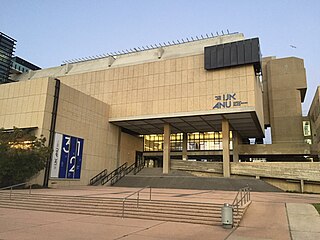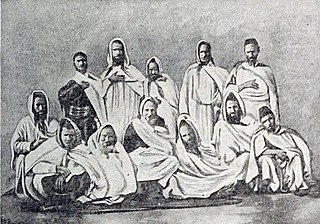The Essenes were a mystic Jewish sect during the Second Temple period that flourished from the 2nd century BCE to the 1st century CE.

Maghrebi Jews or North African Jews are ethnic Jews who had traditionally lived in the Maghreb region of North Africa under Arab rule during the Middle Ages. Established Jewish communities had existed in North Africa long before the arrival of Sephardi Jews, expelled from Portugal and Spain. The term Musta'arabi was also used by medieval Jewish authors to refer to Jews who had traditionally lived in the Maghreb. Due to proximity, the term 'Maghrebi Jews' sometimes refers to Egyptian Jews as well, even though there are important cultural differences between the history of Egyptian and Maghrebi Jews. These Jews originating from North Africa constitute the second largest Jewish diaspora group.

Anu – Museum of the Jewish People, formerly the Nahum Goldmann Museum of the Jewish Diaspora, is located in Tel Aviv, Israel, at the center of the Tel Aviv University campus in Ramat Aviv. The Hebrew Anuאנו means 'we, us'.

The history of the Jews in Tunisia extends nearly two thousand years to the Punic era. The Jewish community in Tunisia is no doubt older and grew up following successive waves of immigration and proselytism before its development was hampered by anti-Jewish measures in the Byzantine Empire. The community formerly used its own dialect of Arabic. After the Muslim conquest of Tunisia, Tunisian Judaism went through periods of relative freedom or even cultural apogee to times of more marked discrimination. The arrival of Jews expelled from the Iberian peninsula, often through Livorno, greatly altered the country. Its economic, social and cultural situation has improved markedly with the advent of the French protectorate before being compromised during the Second World War, with the occupation of the country by the Axis. The Nakba and the creation of Israel in 1948 provoked a widespread anti-Zionist reaction in the Arab world, to which was added nationalist agitation, nationalization of enterprises, Arabization of education and part of the administration. Jews left Tunisia en masse from the 1950s onwards because of the problems raised and the hostile climate created by the Bizerte crisis in 1961 and the Six-Day War in 1967. According to the Jewish Virtual Library, the Jewish population of Tunisia, was estimated at about 105,000 individuals in 1948. These Jews lived mainly in Tunis, with communities present in Djerba. The 2022 Report on International Religious Freedom by the U.S Department of State stated that "according to members of the Jewish community, there are approximately 1,500 Jewish citizens in the country".

Mount Arbel is a mountain in The Lower Galilee near Tiberias in Israel, with high cliffs, views of Mount Hermon and the Golan Heights, a cave-fortress, and ruins of an ancient synagogue. Mount Arbel sits across from Mount Nitai; their cliffs were created as a result of the geological processes leading to the creation of the Jordan Rift Valley.

The history of the Jews in Libya stretches back to the 3rd century BCE, when Cyrenaica was under Greek rule. The Jewish population of Libya, a part of the Sephardi-Maghrebi Jewish community continued to populate the area continuously until the modern times. During World War II, Libya's Jewish population was subjected to antisemitic laws by the Fascist Italian regime and deportations by Nazi German troops.

Berber Jews are the Jewish communities of the Maghreb, in North Africa, who historically spoke Berber languages. Between 1950 and 1970 most emigrated to France, the United States, or Israel.

Syrian Jews had predominantly two origins: those who inhabited Syria from early times and the Sephardim who fled to Syria after the expulsion of the Jews from Spain and Portugal in 1492 CE. There were large Jewish communities in Aleppo, Damascus, and Qamishli for centuries. In the early 20th century, a large percentage of Syrian Jews immigrated to Palestine, the U.S. and Latin America. The largest Syrian-Jewish community is now located in Israel and is estimated to number 80,000.

The Upper Galilee is a geographical region located in northern Israel. Part of the larger Galilee region, it is characterized by its higher elevations and mountainous terrain. The term "Upper Galilee" is ancient, and has been in use since the end of the Second Temple period. From a political perspective, the Upper Galilee is situated within the administrative boundaries of the Northern District.

The Jewish courtyard in Speyer, is an historic and archeological site located in the inner city of Speyer, Germany. Built in stages between 1104 and the 14th century, the courtyard contains some of the oldest and best-preserved Jewish community buildings. Along with the other ShUM-cities of Worms and Mainz, Speyer was the hometown of one of the most important Jewish communities in Middle Ages in northern Europe. Because of its historical importance and its testimony to the European Jewish cultural tradition, the Jewish courtyard was inscribed on the UNESCO World Heritage List in 2021.
The Troglodytae, or Troglodyti, were people mentioned in various locations by many ancient Greek and Roman geographers and historians, including Herodotus, Agatharchides, Diodorus Siculus, Strabo, Pliny, Josephus, Tacitus, Claudius Aelianus, Porphyry.

Nahum Slouschz was a Russian-born Israeli writer, translator and archaeologist. He was known for his studies of the "secret" Jews of Portugal and the history of the Jewish communities in North Africa, mostly, in Libya and Tunisia.

Historic synagogues include synagogues that date back to ancient times and synagogues that represent the earliest Jewish presence in cities around the world. Some synagogues were destroyed and rebuilt several times on the same site. Others were converted into churches and mosques or used for other purposes.

Gharyan is a city in northwestern Libya, in Jabal al Gharbi District, located 80 km south of Tripoli. Gharyan is one of the largest towns in the district. Prior to 2007, it was the administrative seat of Gharyan District.
Tighrinna, also known as Harit il Yhud, was a Jewish village located in the Gharyan District of northern Libya. Several hundred metres separated it from Menzel Tighrinna, where the Muslim population lived. In 1943 there were 343 Jews living in the village, which had two synagogues and Jewish cemetery. The population lived in caves. In 1943, the British occupied the region. Soon after, events in Palestine sparked rioting by local Muslims who looted and burnt of Jewish homes. This led to the depopulation of the village, with refugees fleeing to Israel between 1948 and 1951.
Jebel Dahar is a low sandstone mountain chain of the Médenine Governorate of Tunisia.

Carthage was a city in North Africa located on the eastern side of the Lake of Tunis across from the center of what is now Tunis in Tunisia.
Saul Adadi was a Sephardi Hakham, rosh yeshiva, and paytan in the 19th-century Jewish community of Tripoli, Libya. He was heavily involved in youth education, founding a yeshiva and co-founding and serving as principal of a Talmud Torah. He preserved the pinkasim of the Tripoli Jewish community, unpublished manuscripts of 18th-century Tripoli Jewish leader Rabbi Abraham Khalfon, and sefarim belonging to his father, Hakham Abraham Hayyim Adadi, a senior rabbi of the previous generation.

The Derbent Synagogue, also known as Kele-Numaz is the only synagogue in the city of Derbent in the Russian Republic of Dagestan.














